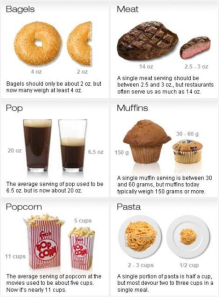Depending on where you live in the U.S. you may refer to Coca Cola or Sprite as soda, pop or soda pop. To be honest, I still haven’t gotten used to hearing or interpreting pop as soda even though I’ve been living in the Mid West for the past year.
While soda and pop are synonymous, the same can’t be said about portions and servings. Yes, it’s understandable how servings and portions could be used interchangeably, but it’s important to recognize the difference and not fall into the pitfalls of “sameness.”
Portion: amount of food we choose to eat
Serving Size: amount of food recommended by the Dietary Guidelines
If you’re familiar with the Dietary Guidelines then your portions may be line with the suggested serving size. However, too many people do not discern the difference. Let’s use some practical application. The Dietary Guidelines state a serving of pasta, rice and/or couscous is 1/3 of cup. However, it’s common practice for one to fill the plate up with pasta, which can easily be at least a cup. In essence, someone’s who’s eating a cup of pasta is eating three servings.
Notable serving sizes:
- 1 slice of bread
- 6″ tortilla
- 1/3 cup of cooked cereal, rice, or pasta
- 1 cup of raw leafy vegetables
- 1/2 cup of other vegetables cooked or raw
- 3/4 cup of vegetable or fruit juice
- 1 medium apple, banana, orange or pear
- 1/2 cup of chopped, cooked, or canned fruit
- 1 cup of milk or yogurt
- 1 1/2 ounces of natural cheese (i.e. Cheddar)
- 2-3 ounces of cooked lean meat, poultry, or fish
- 1/2 cup of cooked dry beans or 1/2 cup of tofu counts as 1 ounce of lean meat
- 2 tablespoons of peanut butter or 1/3 cup of nuts counts as 1 ounce of meat
My point is that it’s not a BAD thing to be eating grains, but to make sure you’re aware of how much you’re eating and how much in accordance with the Dietary Guidelines. The issue that often comes up is that people are eating several servings for several or all their meals on a regular basis.
Motivated to decrease your portion size, but not sure how to start? The best way is to pull out your measuring cups and spoons. We often times “eye” the amount of food we serve ourselves, but when making these portion changes, it’s good to have a good baseline. Additionally, join the Smaller Plate Movement, which as its name suggests promotes the use of more appropriately sized plates, bowls and cups.
Worried that you’ll be starving with smaller portions? I wouldn’t worry yet! You might be surprised that you’re actually more satisfied with your meals with smaller portions because you really got to enjoy the meals.
I’ve written a lot about portion control on this blog, how portions have changed over the years to what a portion is, but all this information is relevant and important to know to make those permanent healthier lifestyle changes! What progress have you made lately?
Photo Credit: High Heeled Life
Sources:http://www.eatright.org/Public/content.aspx?id=4294967941
http://www.nhlbi.nih.gov/health/educational/wecan/eat-right/distortion.htm
http://www.health.gov/dietaryguidelines/dga2000/document/build.htm
http://msue.anr.msu.edu/news/portion_size_vs_serving_size
https://www.pulseos.com/blog/body/body-mass/healthy-weight-portion-control/




A third of a cup of pasta is a serving?! What’s that about 6 ziti macaroni? Maybe for a three year old.
LikeLike